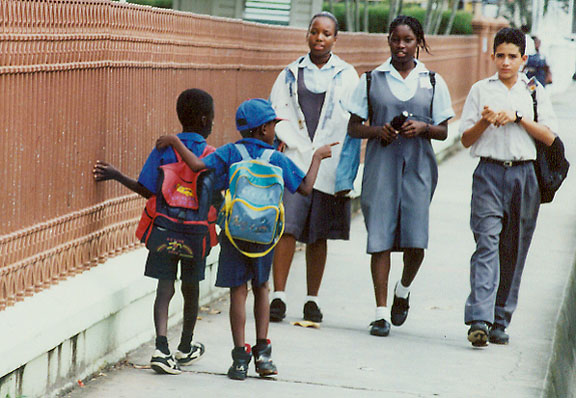Education in Guyana
 |Flag-map of Guyana|thumb]]|thumb]]
|Flag-map of Guyana|thumb]]|thumb]]
|Georgetown street|thumb|left]]|thumb|left]]
Education in Guyana is a fundamental aspect of the nation's development and culture. The education system in Guyana has evolved over the years, reflecting the country's colonial history, its path to independence, and its efforts to provide quality education to all its citizens. The system is overseen by the Ministry of Education, which is responsible for policy development, administration, and the overall supervision of the education sector.
History[edit | edit source]
The history of education in Guyana can be traced back to the colonial era when the education system was primarily established to serve the European population. Over time, with changes in political and social structures, the system expanded to include the wider population. After gaining independence in 1966, Guyana made significant strides in reforming its education system to make it more inclusive and accessible to all citizens.
Structure[edit | edit source]
The education system in Guyana is structured into four levels: Early Childhood Education, Primary Education, Secondary Education, and Tertiary Education.
Early Childhood Education[edit | edit source]
Early Childhood Education in Guyana caters to children from 3 to 5 years of age. This level focuses on basic literacy, numeracy, and social skills, preparing children for primary education.
Primary Education[edit | edit source]
Primary Education serves children aged 6 to 12 years and is compulsory for all children in Guyana. It is divided into six grades, with a National Grade Six Assessment (NGSA) conducted at the end of Grade 6 to determine placement in secondary schools.
Secondary Education[edit | edit source]
Secondary Education in Guyana typically covers students aged 12 to 17 years and is divided into lower and upper secondary. Students at the end of lower secondary take the Caribbean Secondary Education Certificate (CSEC) exams, while those in upper secondary have the option to sit for the Caribbean Advanced Proficiency Examination (CAPE).
Tertiary Education[edit | edit source]
Tertiary Education in Guyana includes universities, technical institutes, and community colleges. The University of Guyana is the country's premier institution for higher education, offering a range of undergraduate and postgraduate programs.
Challenges[edit | edit source]
Despite progress, the education sector in Guyana faces several challenges, including disparities in access to education between urban and rural areas, limited resources, and the need for further improvements in curriculum and teacher training.
Recent Developments[edit | edit source]
In recent years, the Government of Guyana has initiated several projects aimed at improving the quality of education. These include infrastructure development, the introduction of information and communication technology (ICT) in schools, and professional development programs for teachers.
Conclusion[edit | edit source]
Education in Guyana is a dynamic and evolving sector, with ongoing efforts to enhance its quality and accessibility. Through continued investment and reform, Guyana aims to provide all its citizens with the opportunity to achieve their educational potential, thereby contributing to the nation's development and prosperity.
| This article is a stub. You can help WikiMD by registering to expand it. |
Search WikiMD
Ad.Tired of being Overweight? Try W8MD's NYC physician weight loss.
Semaglutide (Ozempic / Wegovy and Tirzepatide (Mounjaro / Zepbound) available. Call 718 946 5500.
Advertise on WikiMD
|
WikiMD's Wellness Encyclopedia |
| Let Food Be Thy Medicine Medicine Thy Food - Hippocrates |
Translate this page: - East Asian
中文,
日本,
한국어,
South Asian
हिन्दी,
தமிழ்,
తెలుగు,
Urdu,
ಕನ್ನಡ,
Southeast Asian
Indonesian,
Vietnamese,
Thai,
မြန်မာဘာသာ,
বাংলা
European
español,
Deutsch,
français,
Greek,
português do Brasil,
polski,
română,
русский,
Nederlands,
norsk,
svenska,
suomi,
Italian
Middle Eastern & African
عربى,
Turkish,
Persian,
Hebrew,
Afrikaans,
isiZulu,
Kiswahili,
Other
Bulgarian,
Hungarian,
Czech,
Swedish,
മലയാളം,
मराठी,
ਪੰਜਾਬੀ,
ગુજરાતી,
Portuguese,
Ukrainian
Medical Disclaimer: WikiMD is not a substitute for professional medical advice. The information on WikiMD is provided as an information resource only, may be incorrect, outdated or misleading, and is not to be used or relied on for any diagnostic or treatment purposes. Please consult your health care provider before making any healthcare decisions or for guidance about a specific medical condition. WikiMD expressly disclaims responsibility, and shall have no liability, for any damages, loss, injury, or liability whatsoever suffered as a result of your reliance on the information contained in this site. By visiting this site you agree to the foregoing terms and conditions, which may from time to time be changed or supplemented by WikiMD. If you do not agree to the foregoing terms and conditions, you should not enter or use this site. See full disclaimer.
Credits:Most images are courtesy of Wikimedia commons, and templates, categories Wikipedia, licensed under CC BY SA or similar.
Contributors: Prab R. Tumpati, MD



